
Alternative wine closures
Encyclopedia

Wine
Wine is an alcoholic beverage, made of fermented fruit juice, usually from grapes. The natural chemical balance of grapes lets them ferment without the addition of sugars, acids, enzymes, or other nutrients. Grape wine is produced by fermenting crushed grapes using various types of yeast. Yeast...
industry for sealing wine bottle
Wine bottle
A wine bottle is a bottle used for holding wine, generally made of glass. Some wines are fermented in the bottle, others are bottled only after fermentation. They come in a large variety of sizes, several named for Biblical kings and other figures. The standard bottle contains 750 ml,...
s in place of traditional cork
Cork (material)
Cork is an impermeable, buoyant material, a prime-subset of bark tissue that is harvested for commercial use primarily from Quercus suber , which is endemic to southwest Europe and northwest Africa...
closures. The emergence of these alternatives has grown in response to quality control efforts by winemakers to protect against "cork taint
Cork taint
Cork taint is a broad term referring to a wine fault characterized by a set of undesirable smells or tastes found in a bottle of wine, especially spoilage that can only be detected after bottling, aging and opening...
" caused by the presence of the chemical trichloroanisole
2,4,6-Trichloroanisole
2,4,6-Trichloroanisole is a chemical compound that is a chlorinated derivative of anisole.Trichloroanisole is a fungal metabolite of 2,4,6-trichlorophenol, which is used as a fungicide. It can be found in minute traces on packaging materials stored in the presence of fiberboard treated with...
(TCA).
The closures debate, chiefly between supporters of screw caps and natural corks, has increased the awareness of post-bottling wine chemistry
Wine chemistry
Wine is a complex mixture of chemical compounds in a hydro-alcoholic solution with a pH around 3.- Types of natural molecules present in wine :* Acids in wine* Phenolic compounds in wine* Proteins in wine* Sugars in wine* Tryptophol and amino acids derivatives...
, and the concept of winemaking has grown to continue after the bottling process, because closures with different oxygen transmission rate
Oxygen Transmission Rate
Oxygen transmission rate is the measurement of the amount of oxygen gas that passes through a substance over a given period. It is mostly carried out on non-porous materials, where the mode of transport is diffusion, but there are a growing number of applications where the transmission rate also...
s may lead to wines that taste different when they reach consumers.
The cork-industry group APCOR
APCOR
Associação Portuguesa da Cortiça is the Portuguese Cork Association, a consortium of cork growers and manufacturers. It was founded in 1956 and is based in the town of Santa Maria de Lamas in northern Portugal...
cites a study showing a 0.7-1.2% taint rate. In a 2005 study of 2800 bottles tasted at the Wine Spectator
Wine Spectator
Wine Spectator is a lifestyle magazine that focuses on wine and wine culture. It publishes 15 issues per year with content that includes news, articles, profiles, and general entertainment pieces...
blind-tasting facilities in Napa, California, 7% of the bottles were found to be tainted.
Synthetic corks
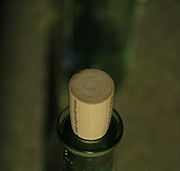
Plastic
A plastic material is any of a wide range of synthetic or semi-synthetic organic solids used in the manufacture of industrial products. Plastics are typically polymers of high molecular mass, and may contain other substances to improve performance and/or reduce production costs...
compounds designed to look and "pop" like natural cork, but without the risk of TCA contamination. Disadvantages of some wine synthetic corks include a risk of harmful air entering a bottle after only 18 months, as well as the difficulty in extracting them from the bottle and using the plastic cork to reseal the wine. James Laube
James Laube
James Laube is an American wine critic, writing for Wine Spectator since 1980, a full-time staff writer since 1983, with expertise on California wine...
of Wine Spectator notes that some can also impart a slight chemical flavour to the wine.
Unlike natural corks, many wine synthetic corks are made from material that is not biodegradable but recyclable as either #4 or #7 (see resin identification code
Resin identification code
The SPI resin identification coding system is a set of symbols placed on plastics to identify the polymer type. It was developed by the Society of the Plastics Industry in 1988, and is used internationally....
) in many communities. There are two main production techniques for synthetic wine closures: injection molding and extrusion (mono- and co-). Methods also exist which are claimed to combine the two techniques of injection and extrusion. A 2007 study by Victor Segalen Bordeaux 2 University
Victor Segalen Bordeaux 2 University
Université Victor Segalen Bordeaux 2 is the medicine and life sciences center in the University of Bordeaux system, under the Academy of Bordeaux....
showed that injection molded synthetic corks allowed the highest levels of oxygen
Oxygen
Oxygen is the element with atomic number 8 and represented by the symbol O. Its name derives from the Greek roots ὀξύς and -γενής , because at the time of naming, it was mistakenly thought that all acids required oxygen in their composition...
permeation
Permeation
Permeation, in physics and engineering, is the penetration of a permeate through a solid, and is related to a material's intrinsic permeability...
in when compared to natural cork and screw caps, offering the lowest protection against oxidation of the wine.
An advanced new generation of injection molded synthetic closures have developed a system of nano-cells as to perfectly replicate the cellular structure of natural cork and by exactly duplicating the permeability values of the top-quality-one-piece natural corks.,
Screw caps
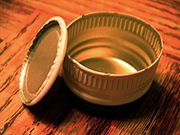
Aluminium
Aluminium or aluminum is a silvery white member of the boron group of chemical elements. It has the symbol Al, and its atomic number is 13. It is not soluble in water under normal circumstances....
material that threads onto the bottleneck. They are the predominant closure used by New Zealand wineries. This can be attributed in part to the New Zealand screw cap initiative which promotes the use of screw caps instead of cork. Screw caps form a tighter seal and can keep out oxygen for a longer time than cork. These benefits aid in maintaining the wine's overall quality and aging potential. Michel Laroche of Domaine Laroche noted that this played a role in his decision to adopt screwcaps. "Extensive quality tests show convincing results: apart from protecting against cork taint, screwcaps are also beneficial in the aging of wine
Aging of wine
The aging of wine, and its ability to potentially improve wine quality, distinguishes wine from most other consumable goods. While wine is perishable and capable of deteriorating, complex chemical reactions involving a wine's sugars, acids and phenolic compounds can alter the aroma, color,...
, particularly preserving the aromatic freshness."
An often cited contradiction is the case of experiments carried out by Château Haut-Brion
Château Haut-Brion
Château Haut-Brion is a French wine, rated a Premier Cru Classé , produced in the Gironde region. It differs from the other wines on the list in its geographic location in the north of the wine-growing region of Graves...
in the 1970s, when 100 bottles were placed under screwcap for long term observation. The result was, according to Haut-Brion manager Jean-Bernard Delmas, that "it worked perfectly for the first ten years, until the plastic in the caps went brittle and let air in".
A disadvantage of screw caps according to wine expert Jancis Robinson
Jancis Robinson
Jancis Mary Robinson OBE, MW is a British wine critic, journalist and editor of wine literature. She currently writes a weekly column for the Financial Times, and writes for her website jancisrobinson.com...
is the opposite of oxidation, reduction, which may suppress a wine's aroma and possibly cause unpleasant ones, a problem that particularly affects Sauvignon blanc
Sauvignon blanc
Sauvignon Blanc is a green-skinned grape variety which originates from the Bordeaux region of France. The grape most likely gets its name from the French word sauvage and blanc due to its early origins as an indigenous grape in South West France., a possible descendant of savagnin...
which is a grape variety with natural tendencies toward reduction. Furthermore there is the screwcap's public image, as "consumers still perceive screwcaps as being for 'cheap' wines (regardless of the price tag)".
In a 2004 study of consumer opinions conducted by the wine consulting firm Wine Intelligence found that nearly 52% of American consumers and 60% of British consumers reject the idea of using screwcaps for their fine wine. The 2007 Victor Segalen University study in Bordeaux
Bordeaux
Bordeaux is a port city on the Garonne River in the Gironde department in southwestern France.The Bordeaux-Arcachon-Libourne metropolitan area, has a population of 1,010,000 and constitutes the sixth-largest urban area in France. It is the capital of the Aquitaine region, as well as the prefecture...
showed that screw caps closures allowed the lowest amount of oxygen
Oxygen
Oxygen is the element with atomic number 8 and represented by the symbol O. Its name derives from the Greek roots ὀξύς and -γενής , because at the time of naming, it was mistakenly thought that all acids required oxygen in their composition...
permeation
Permeation
Permeation, in physics and engineering, is the penetration of a permeate through a solid, and is related to a material's intrinsic permeability...
when compared to natural and synthetic corks, offering the highest level of protection against oxidation of the wine.
Following studies by the faults clinic at the International Wine Challenge
International Wine Challenge
The International Wine Challenge is an annual wine competition. The International Wine Challenge assesses every wine blind and judges each for its faithfulness to variety, region and vintage. Every wine is assessed independently of its price...
in September 2006, it became widely reported in British newspapers that test results show that one in 50 screwcap bottles, 200,000 bottles worldwide, may be affected by the chemical process sulphidisation
Sulfide
A sulfide is an anion of sulfur in its lowest oxidation state of 2-. Sulfide is also a slightly archaic term for thioethers, a common type of organosulfur compound that are well known for their bad odors.- Properties :...
, resulting in a flaw in which a consumer would be "confronted with the reek of sulphur - likened to burning rubber or rotten eggs - rather than an attractive bouquet". Jamie Goode
Jamie Goode
Jamie Goode is a British author with a PhD in plant biology, and a wine columnist of The Sunday Express. Goode also contributes to wine publications such as Harpers, The World of Fine Wine, Decanter, GrapesTALK and Sommelier Journal....
presented arguments against reports he described to "represent the science of closures badly, are filled with inaccuracies and misunderstandings, and do not serve the wine industry well", and addressed the inaccuracies in specific points.
Vino-Seal
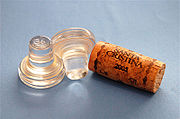
Glass
Glass is an amorphous solid material. Glasses are typically brittle and optically transparent.The most familiar type of glass, used for centuries in windows and drinking vessels, is soda-lime glass, composed of about 75% silica plus Na2O, CaO, and several minor additives...
closure released by Alcoa
Alcoa
Alcoa Inc. is the world's third largest producer of aluminum, behind Rio Tinto Alcan and Rusal. From its operational headquarters in Pittsburgh, Pennsylvania, Alcoa conducts operations in 31 countries...
. Since its introduction into the European market in 2003, over 300 wineries have utilized Vino-Seal. Using a glass stopper with an inert o-ring, the Vino-Seal creates a hermetic seal
Hermetic seal
A hermetic seal is the quality of being airtight. In common usage, the term often implies being impervious to air or gas. When used technically, it is stated in conjunction with a specific test method and conditions of usage.-Etymology :...
that prevents oxidation and TCA contamination. A disadvantage with the Vino-Seal is the relatively high cost of each plug (70 cents each) and cost of manual bottling due to the lack of compatible bottling equipment outside of Europe.
Zork
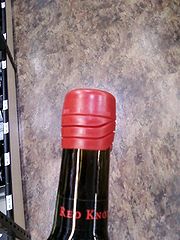
The ZORK STL's inspiration came from Conor McKenna and was designed by John Brooks in Adelaide, South Australia, Zork STL is an alternative wine closure for still wines that seals like a screw cap and pops like a cork. It is made in Australia, the USA & Europe (Italy). The ZORK STL closure consists of three parts; an outer cap providing a tamper evident clamp that locks onto the band of a standard cork mouth bottle, an inner metal foil which provides an oxygen barrier similar to a screw cap, and an inner plunger which creates the ‘pop’ on extraction and reseals after use.
Released in 2010, the ZORK SPK is the first on-bottle, resealable closure for sparkling wines. Consumers can use the mushroom-shaped ZORK SPK closure to reseal the bottle, retaining the fizz between glasses. It is currently only manufactured in Australia but has been seen on sparkling bottles globally.
Crown caps
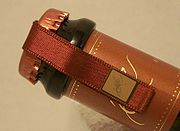
Bottle cap
Bottle caps are a type of closure used to seal the openings of bottles of many types. They can be small circular pieces of metal, usually steel, with plastic backings, and for plastic bottles a plastic cap is used instead. A bottle cap is typically colorfully decorated with the logo of the brand...
has been used in the sparkling wine
Sparkling wine
Sparkling wine is a wine with significant levels of carbon dioxide in it making it fizzy. The carbon dioxide may result from natural fermentation, either in a bottle, as with the méthode champenoise, in a large tank designed to withstand the pressures involved , or as a result of carbon dioxide...
industry as a closure during the bottle fermentation process (méthode traditionnelle). Normally the cap is replaced with a cork before shipping, though recently some producers are releasing wines using the crown cap as their closure. Although easier to open, crown caps eliminate part of the ceremony and mystique of opening a sparkling wine.
Opposition
There is continuing opposition to the use of alternative closures in some parts of the Winemaking industry. In March 2006, the Spanish government outlawed the use of alternative wine closures in 11 of Spain's wine producing regions as part of their (Denominacion de OrigenDenominación de Origen
Denominación de Origen is part of a regulatory classification system primarily for Spanish wines but also for other foodstuffs like honey, meats and condiments. In wines it parallels the hierarchical system of France and Italy although Rioja and Sherry preceded the full system...
) D.O. regulations.
Although environmentalists lament the loss of cork forests to commercial crops such as eucalyptus, advocates of artificial corks point out that "natural corks" are just "granules and dust bonded with solvents", and no more biodegradable than the artificial product.
It should be pointed out that "granules and dust bonded with solvents" describes "agglomerate corks." These differ from "natural corks" that are one piece made out of cork bark.
External links
- New Zealand Screw Cap Initiative official site
- "The History and Revival of Screwcaps" Wine of the Week webzine

